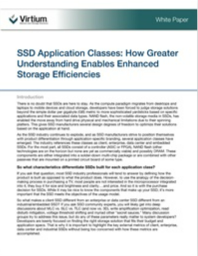SSD Application Classes: How Greater Understanding Enables Enhanced Storage Efficiencies
As the compute paradigm migrates from desktops and laptops to mobile devices and cloud storage, developers have been forced to judge storage solutions beyond the simple dollar per gigabyte (GB) metric to more sophisticated facilities based on specific applications and their associated data types.
NAND flash, the non- volatile storage media in SSDs, has enabled the move away from hard drive physical and mechanical limitations due to their spinning platters. This gives SSD manufacturers several design degreees of freedom to optimize their solutions based on the application at hand.
Download this whitepaper to find out more.
Read More
By submitting this form you agree to Virtium LLC contacting you with marketing-related emails or by telephone. You may unsubscribe at any time. Virtium LLC web sites and communications are subject to their Privacy Notice.
By requesting this resource you agree to our terms of use. All data is protected by our Privacy Notice. If you have any further questions please email dataprotection@techpublishhub.com
Related Categories: Embedded, Industrial


More resources from Virtium LLC

Serialization and Traceability of Storage Products
Virtium's focus is to provide high- reliability storage products to OEMs making infrastructure and communications equipment for the Internet of Thi...

Temperature Considerations for Industrial Embedded SSDs
This white paper discusses the affects that extended high temperatures have on SSDs. It discusses endurance and data retention characteristics of S...

Choices in Advanced - TCA Storage Technology
Along with compactness, higher functionality and density, as well as reliability, non- volatility, faster access speed, and lighter weight make AMC...

